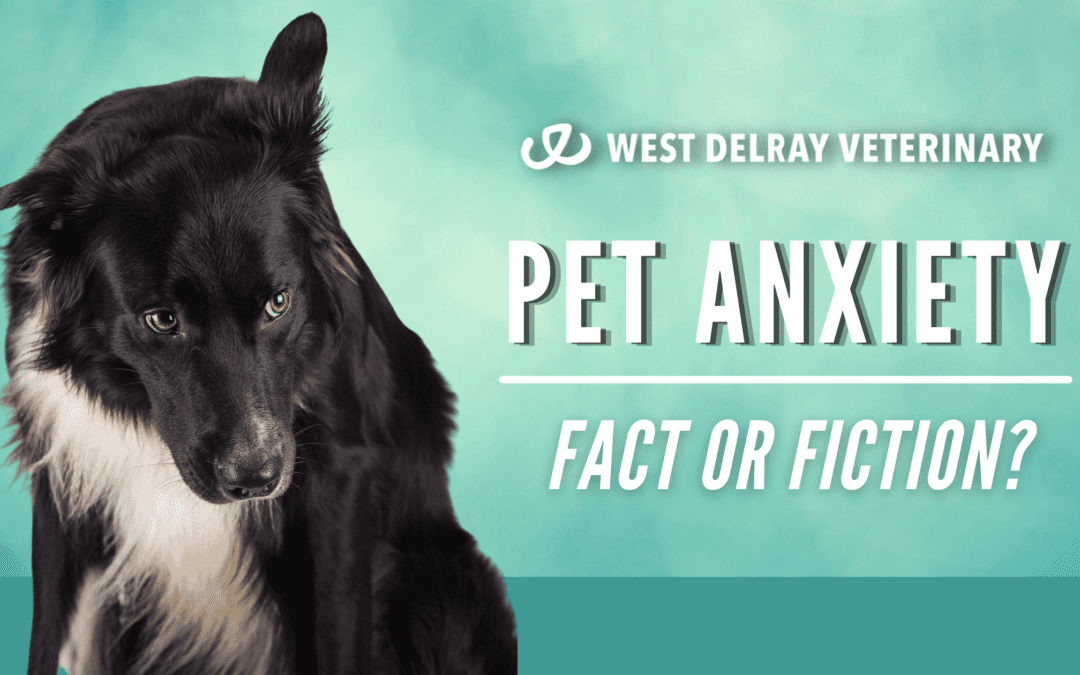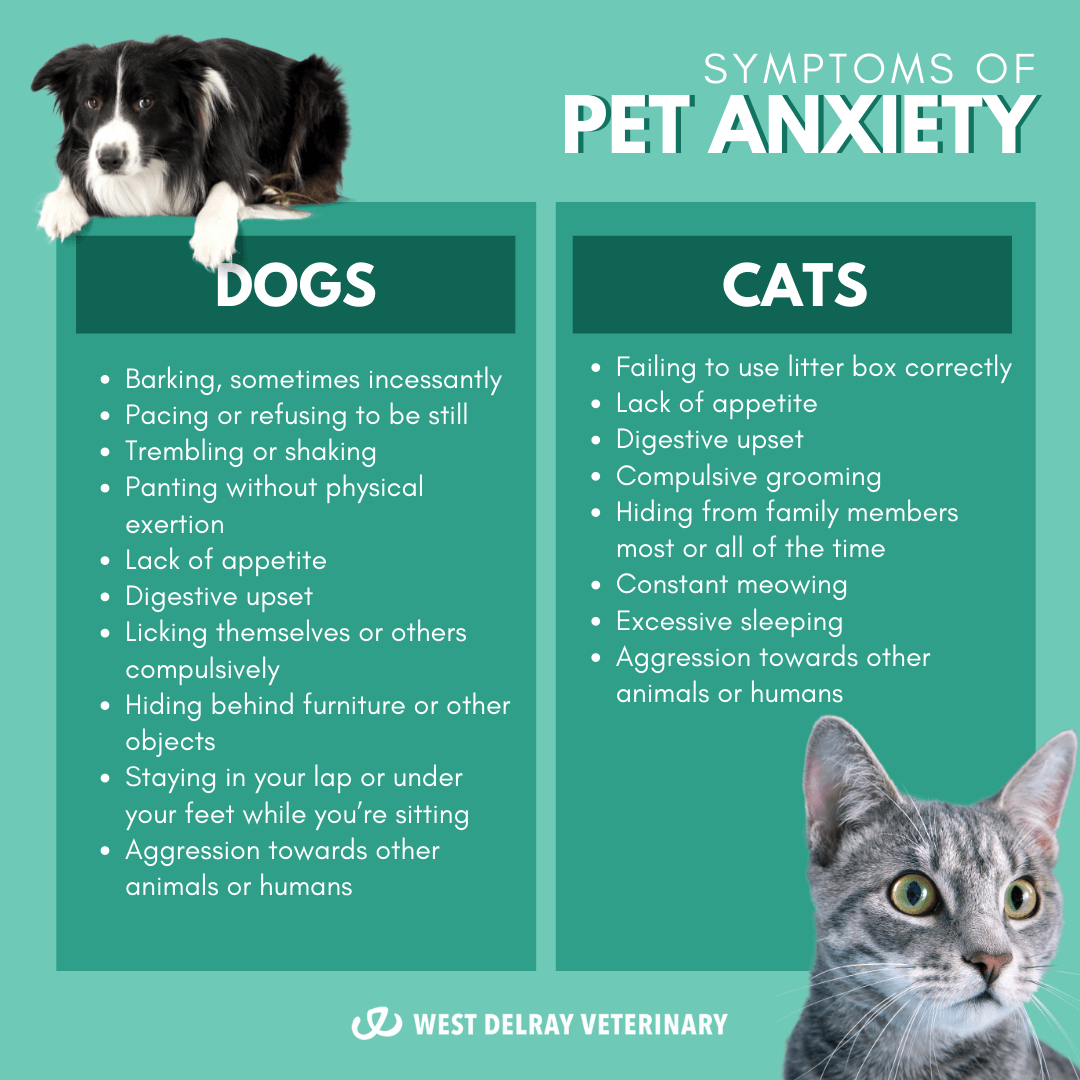For this month’s blog, we explain everything you need to know about pet anxiety- the common causes, symptoms, and treatments.
Anxiety is not limited to the human species. In fact, anxiety is a condition that is common in both humans and pets! At West Delray Veterinary, many of our clients observe some degree of anxiety in their own pets.
Anxiety can be defined as feelings of apprehension, unease, and/or nervousness regarding an imminent event, uncertain outcome, or an anticipated threat or danger. It is an emotion that all pets experience from time to time, and it affects each individual pet differently. But, if left untreated, pet anxiety can lead to various behavioral issues.
Treating your pet’s anxiety starts by trying to identify the potential causes or triggers of their distress. From there we can work together to find solutions to help improve your pet’s quality of life surrounding these triggers.
Common Causes of Anxiety in Pets
Unfortunately there are many things that may contribute to anxiety in our furry friends. Some of the most common causes of anxiety are fear-related, separation related, and aging changes.
Fear-related anxiety can be caused by visual or auditory stimuli (eg. thunder, hats, vacuum cleaner, fireworks), strange people or animals, new environments, and specific situations (such as veterinary visits or car rides). With separation anxiety, a pet becomes distressed when left alone or separated from family members. This anxiety often manifests itself in undesirable behaviors, such as urinating or defecating in the house, destroying household items, and vocalizing. Age-related anxiety affects older pets and can be associated with cognitive dysfunction syndrome.
Most forms of anxiety can be reduced through training and conditioning. However, it’s important to keep in mind that we have other things that can be used to help reduce anxiety and make training and conditioning more successful!
What Are the Symptoms of Anxiety in Pets?
Every pet expresses their anxiety in unique ways, just like humans do. Most pet parents are able to detect when something is “off” with their pet. But, the problem about anxiety is that it can sometimes be mistaken as a physical illness. Learn the key symptoms of pet anxiety in the graphic image.
So, how can you calm an anxious pet?
There are several ways to handle your pet’s anxiety.
While cuddling and reassuring your pet when they are anxious is a natural response, it is often the WRONG thing to do as it can make pets need our reassurance to get through fearful events. Instead, try distracting them with play or a food toy to give your pet something else to focus on during that anxiety-producing event. If they have a particular noise phobia like storms or fireworks, having music or the TV on can help to “drowned out” the offensive noise for your pet. If they have a “safe space” in your home that they often go to when they’re stressed, make sure they can access that space when needed so they can feel comfortable. When it comes to other animals or people, sometimes it’s best to give our pets their own space if they are too stressed.
Behavioral modification involved techniques to resolve the problem. If you can figure out the main cause of your pet’s stress, slowly build their exposure to the stressor. This is often best done in conjunction with a good trainer who helps to provide positive tools for improving your pet’s behavior.
Swaddling is used in human babies to provide comfort by wrapping them snugly in a blanket. Believe-it-or-not, there are similar benefits for our pets. Calming t-shirts like the ThunderShirt can reduce anxiety associated with travel, separation, noise, or stressful events like vet visits. Additionally, calming pheromone sprays can be applied to these calming shirts as an added benefit to managing the anxiety.
Another method to ease pet anxiety is environmental modification, which means attempting to ease your pets anxiety by altering their current environment. This includes playing calming music or using white noise machines. Pet-safe calming essential oils (like Doterra or Young Living) can also be an effective option for pets. There are also pheromone diffusers and sprays for both dogs and cats that help reduce anxiety associated with car rides, veterinary visits, and separation anxiety. They may also help reduce the stress of adoption and aid in socialization. At West Delray Veterinary, we use them inside our office!
It is essential that, in addition to utilizing the above suggestions, you talk openly with your veterinarian about your concerns. In addition to pet-specific training tips or trainer referrals, depending on the situation, they may also suggest a pharmaceutical prescription or herbal supplement. There are many different types of medications and herbal supplements available for both dogs and cats that may be helpful to make behavioral modification efforts more successful!
At West Delray Veterinary, we often utilize several pharmaceutical options (such as gabapentin, trazodone, fluoxetine, Sileo, and others). Additionally, our Veterinarians may recommend calming herbs and supplements such as L-Theanine, Homeopathics, and Therapeutic Hemp or CBD.
Click here to schedule your initial consultation with Dr. Jonathan Block or Dr. Melanie Thomas, or Dr. Nicole Patterson to find the best solution for your pet’s anxiety.
At West Delray Veterinary, we know that anxiety in your pet can cause you to have anxiety too! We want all of our pet parents to have all the essential tools and knowledge to assist their pets in a stressful situation.
Book an appointment here.
Click here to download our “How To Calm an Anxious Pet” handout


